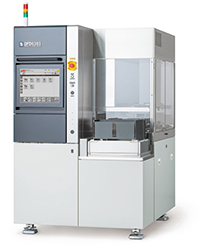Improved Process Adaptability Development of DFD6363, Fully-Automatic Blade Dicing Saw for Φ300 mm Wafers
DISCO CORPORATION, a semiconductor manufacturing equipment manufacturer (Headquarters: Ota-ku, Tokyo; President: Kazuma Sekiya), has developed DFD6363, a fully-automatic blade dicing saw capable of processing Φ300 mm Si wafers. DFD6363 is the improved process adaptability version of DFD6362, which has been widely adopted for use in semiconductor manufacturing with Φ300 mm Si wafers. This equipment will be exhibited at SEMICON Japan 2018 (December 12 to 14 at Tokyo Big Sight).
Development Background
The semiconductor market is expected to expand due to the development of IoT and AI, the rise in
electric vehicles, and the increasing demand for server storage due to the increase in communication
data. In response to Φ300-mm Si wafer mass production demands, DISCO provided DFD6362 and DFD6361,
which are now in operation at semiconductor manufacturers worldwide.
However, there is further demand for improvements in productivity as a result of recent progress in
the diversification of the semiconductor manufacturing process. In order to meet these demands,
DFD6363 was developed and added to our blade dicing saw lineup.

Features of DFD6363
Compatible with various applications
- Frame Handling and Wafer Handling Compatibility※1
It is possible to use both frame handling and wafer handling without the need to convert the handling mechanism. Because of this, it is possible to support not only the full cut process using frame handling, but also the DBG process※2 where die singulation is performed by directly transferring the wafer onto the dicing saw and grinding the backside of the wafer after the half cut process. - Uptime Improvement Using Automatic Blade Changer※1
The Auto Blade Changer (ABC) helps to minimize downtime by automatically detecting when a blade is worn, changing the blade, and continuing processing. Moreover, it also prevents blade type mistakes as a result of changes in the workpiece being processed.
Basic Function Improvements
- Large Display Monitor
By increasing the conventional 15-inch display size to 19 inches, the amount of information that can be displayed is increased and visibility and operability are improved. - Operation Wait Time Reduction through Multiple-Axis Synchronized Control
Because the three axes (processing table axis, cut positioning axis, and cut depth adjustment axis) which were originally controlled individually are now controlled simultaneously, the axis operation wait time is reduced. - New 1.8 kW Spindle for Improved Processing Stability
The 1.8 kW spindle is comparable in size to the conventional 1.2 kW spindle and has 50% higher torque, which allows for improved processing stability. - Improved Productivity Using New NCS (Non-Contact Setup)※1
The NCS, which calibrates the blade height with respect to the processing table, was improved, resulting in a 74% reduction in measurement time. Moreover, the processing stability was further improved through increased NCS measurement accuracy.
Schedule
| December 2018 | Exhibition at SEMICON Japan 2018 |
|---|---|
| October 2019 | Plan to start selling |
※1 Available as an optional feature.
※2 The DBG process (Dicing Before Grinding) is the reverse of the conventional process of grinding first,
then singulating the wafer. A wafer is half cut first, and then the wafer is singulated into die by
grinding the wafer. Because the risks of backside chipping during die separation and wafer breakage can be
prevented, it has been widely adopted for memory production with Φ300-mm wafers.
Contact
Please feel free to contact us with any questions or inquiries.
